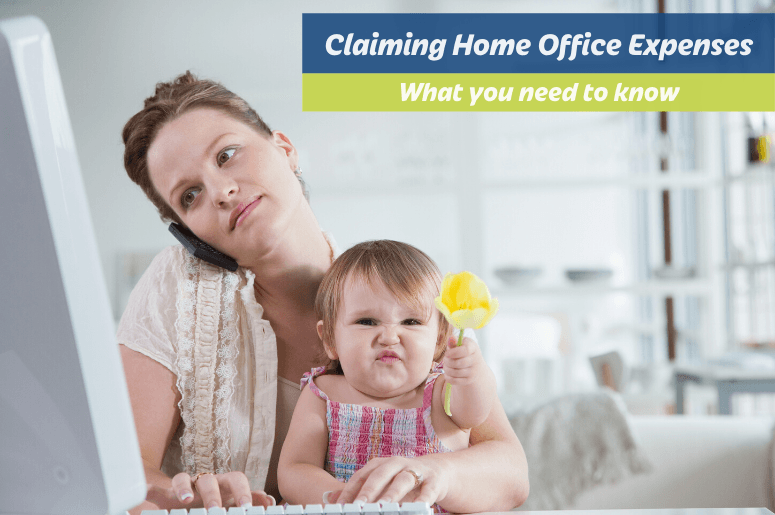Working from home? A guide for claiming home office expenses that keeps you out of trouble with the ATO…

Claiming home office expenses: the three basic conditions
Working from your home office may incur costs that you are able to deduct in your annual tax return.
However, the ATO has announced that it will exercise additional scrutiny over home office deductions to identify incorrect claims, which will be disallowed.
It is important to know what you can claim and what information you need to keep if you are making a claim.
When claiming home office expenses, the following three basic conditions must be met:
1. You must have spent the money
To claim an expense, you must have incurred an expense!
For example, if you hire a cleaner to maintain your home office, you have incurred an expense and you may be able to claim the cost of those cleaning services.
If you choose not to hire a cleaner, you cannot claim for the hours that you spent cleaning your home office.
Sometimes, employers will reimburse you for any additional costs incurred when working from home.
In such cases, the ATO’s view is that you did not spend the money. It was spent by the person who reimbursed you (your employer).
So, if you spent $50 to hire a cleaner and your employer pays you back for this, you cannot claim it.
2. Money spent must relate to making an income
To claim a home office deduction, the money must have been spent in relation to the income you earn.
You cannot buy a television for personal entertainment, place it in your home office and then claim it because the television does not enable you to earn income.
Additionally, when you incur a cost that is partially for business purposes and partially for personal use, such as your mobile phone bill, you can only claim the business-related portion.
3. You must have a record of the expense
If the ATO audits your tax return, you must provide a record (such as the tax invoice) to prove that you paid for the item.
Alternatively, you will need to provide a representative four-week diary of the hours that you work from home.
Small business accountants recommend that you keep your tax records for seven years.
Claiming home office expenses: the two calculation methods
There are two methods of claiming home office expenses:
1. Fixed rate
You can claim a deduction of 52 cents for each hour you work from home instead of recording all of your actual expenses (heating, cooling, lighting, cleaning, decline in value of furniture, etc.)
This rate is based on the average energy costs and the value of common furniture items used in home business areas.
To claim using this method, keep either:
- Records of your actual hours spent working at home for the year; or
- A diary for a representative four-week period to show your usual pattern of working at home
With the latter method, you can apply the four-week representative period across the remainder of the year to determine your full deduction amount.
However, if your work pattern changes you will need to create a new record.
You need to separately work out all other home work area expenses, such as:
- Phone and internet expenses
- Computer consumables and stationery
- Decline in the value of computers or other equipment
The ATO has just announced that individuals can claim a rate of 80 cents for each hour an individual carries out genuine work duties from home during the period 1st March 2020 to 30th June 2020. This rate however covers all deductible running expenses like phone and internet expenses, computer consumables, depreciation and electricity!
2. Actual running expenses
If you work from home, you can claim the work-related proportion of your running expenses.
The proportion is based on the amount of expense used for the business.
Expenses include:
- Home office equipment including computers, printers, telephones and furniture and furnishings. You can claim:
- The full cost for items up to $300
- The decline in value for items over $300
- Heating, cooling, and lighting
- The costs of repairs to your home office equipment, furniture, and furnishings
- Cleaning costs
- Other running expenses, including computer consumables (for example, printer paper and ink) and stationery
Only the additional running expenses incurred as a result of working from home are deductible.
If you are only claiming the running expenses, there is no capital gains tax (CGT) consequences on your house.
Can you claim for your rent or mortgage when working from home?
Employees are generally not able to claim occupancy expenses such as:
- Rent
- Mortgage interest
- Property insurance
- Land taxes
- Rates
Businesses can claim occupancy expenses.
You can only claim for the work-related proportion of occupancy expenses as an employee in two very limited circumstances, when:
- The space in your home is a place of business
- No other work location is provided to you by your employer and you are required to dedicate part of your home to your employer's business as an office.
If you claim occupancy expenses, you don't qualify for the CGT main residence exemption for the part of your home that you use for work.
Note that if you use your home as a place of business, there may also be CGT implications when you sell it.
Need help with understanding home office expenses?
Claiming home office expenses is not as straightforward as some employers or employees think.
The COVID-19 outbreak has placed many businesses and staff members in a position that they didn’t imagine only a month or so ago.
If you need assistance with unravelling the regulations about claiming home office expenses, speak to one of our advisers here.
Need help with your accounting?








